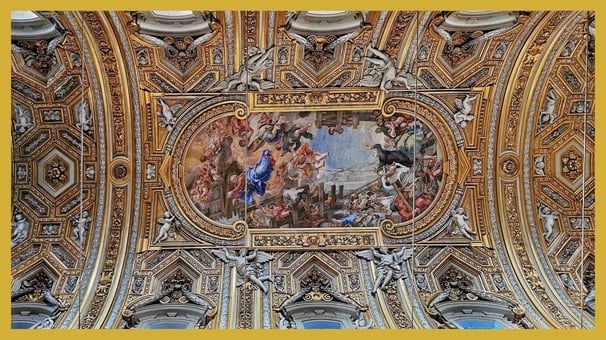Catholic Art and Architecture in Rome: The Lasting Impact of the Jubilee
Contents
The Jubilee's Lasting Impact on Roman Architecture
Sacred Art and Catholicism
The Churches: Monuments of Faith and Art
The Jubilee: Catalyst for Artistic Development
Conclusion
Rome, for centuries the epicenter of Christianity, owes much of its artistic and architectural heritage to the Jubilee and to Catholicism. Each Jubilee has profoundly shaped both the city's art and its infrastructure, driving the creation of major structures like St. Peter’s Basilica, the Holy Stairs—steeped in religious significance—and the Church of Sant’Agnese in Agone. This era also sparked an extraordinary boom in artistic production. As one walks through Rome today, they can admire countless masterpieces, from religious monuments to sacred artworks, serving as living testaments to the enduring effects of the Catholic faith and the Jubilees over the centuries. Every corner of Rome narrates a story, with each stone bearing witness to Catholicism’s deep-seated roots in both European and global culture


The Jubilee's Lasting Impact on Roman Architecture
Since the first Jubilee in 1300, proclaimed by Pope Boniface VIII, the desire to accommodate thousands of pilgrims catalyzed urban transformations in the city, leading to the construction of new roads, bridges, and expanded infrastructure to enhance accessibility to key places of worship. The need for adequate space and wider roads spurred the development of new streets and monumental squares. A notable case is the reconstruction of St. Peter’s Basilica, initiated under Pope Julius II precisely to prepare for the 1500 Jubilee. This formidable structure, crafted by architects like Bramante, Michelangelo and Bernini, stands not only as the heart of Catholicism but also as a global architectural masterpiece
The 1500 Jubilee heralded a significant era for the city, as it saw the completion of not just St. Peter’s Basilica but also other pivotal projects like the fortification of the Vatican walls and the construction of new facilities to accommodate pilgrims. These material transformations solidified Rome's position as the spiritual and artistic nucleus of Christianity. Michelangelo, with his innovative vision and exceptional technical prowess, played a crucial role in molding a Rome that merged devotional and aesthetic splendor seamlessly.
The 1600 Jubilee, initiated by Pope Clement VIII, equally left a substantial imprint, with extensive renovations of numerous churches and widened roads connecting sacred sites. This period marked the blossoming of Baroque architecture, with masters like Bernini and Borromini imprinting their style on Rome. An illustration of such grandeur is the Church of Sant’Agnese in Agone, characterized by its imposing Baroque façade and the dome conceived by Borromini. Prominent squares such as Piazza Navona and Piazza di Spagna were further enhanced, celebrating Catholicism’s magnificence, thereby forging a city where the sacred and the secular coalesce into a perfect symbiosis
Sacred Art and Catholicism
Catholicism has profoundly shaped Rome's artistic landscape, giving rise to masterpieces that reflect the city's spirituality and the religious fervor of its inhabitants. Esteemed artists like Caravaggio, Raphael and Michelangelo have extensively engaged with sacred art, producing iconic works now gracing key venues such as St. Peter's Basilica, Chiesa di Santa Maria del Popolo, and Chiesa di Santa Maria in Vallicella across the city
Among the iconic works is the Sistine Chapel featuring Michelangelo's Last Judgment, one of art history’s most acclaimed creations. This fresco marks the apogee of Renaissance art and embodies the profound interplay between Catholic faith and visual art. Michelangelo devoted years to crafting this masterpiece, tirelessly aiming to represent both the divine glory and the complexity of the human condition. Each detail and figure in the fresco is richly imbued with religious symbolism, offering viewers a profound spiritual journey.
Caravaggio's Conversion of Saint Paul, housed in the Chiesa di Santa Maria del Popolo, exemplifies the dramatic and spiritually intense style characteristic of his work. With his mastery over chiaroscuro, Caravaggio captures the essence of Paul’s miraculous conversion, rendering an emotionally and spiritually powerful piece. His near-theatrical realism makes the sacred art strikingly poignant and directly connects viewers with their faith.
Raphael also significantly enhanced Rome's sacred art landscape with his works in the Chiesa di Santa Maria della Pace and the Vatican Rooms, showcasing some of the finest Italian Renaissance expressions. His Madonnas, embodying serenity and gentleness, evoke a profound sense of peace and devotion, deeply reflecting the Catholic spirit of his era.
The Churches: Monuments of Faith and Art
Roma è disseminata di chiese che non solo fungono da luoghi di culto, ma sono anche veri e propri musei a cielo aperto, dove è possibile ammirare opere d'arte e architetture di straordinaria bellezza. Durante il Giubileo, queste chiese diventano mete di pellegrinaggio e offrono ai visitatori la possibilità di riflettere sulla loro fede attraverso l'arte. Ad esempio, i pellegrini possono partecipare a processioni, recitare il rosario in gruppo o prendere parte alle celebrazioni liturgiche speciali organizzate per l'occasione. Tra i luoghi imperdibili c'è la Chiesa di Sant'Ignazio di Loyola, famosa per gli affreschi illusionistici di Andrea Pozzo, che creano l'illusione di uno spazio infinito sulla volta.
Rome is peppered with churches that not only serve as places of worship but also stand as open-air museums showcasing breathtaking artworks and architecture. During the Jubilee, these churches transform into pilgrimage destinations, offering visitors an opportunity to contemplate their faith through art. Pilgrims might engage in processions, group rosary recitations, or special liturgical celebrations specifically organized for these occasions. A must-visit is the Chiesa di Sant'Ignazio di Loyola, renowned for Andrea Pozzo's illusionistic frescoes, which brilliantly conjure the illusion of an infinite space across the vault
Another example is the Church of Sant'Andrea della Valle, with its imposing dome frescoed by Giovanni Lanfranco and the apse basin decorated by Domenichino, exemplifying some of the finest representations of Roman Baroque art. The church serves as a sanctuary of peace and reflection, where art transcends its form to elevate the spirit and foster a closer connection to the divine. Each architectural detail, from the columns to the side altars, has been meticulously designed to create an atmosphere of solemnity and beauty, making the visit a spiritual and aesthetic experience.
The churches of Rome, such as the Basilica of St. John Lateran and the Basilica of St. Mary Major, are quintessential examples of how sacred architecture can express the glory of God and the significance of the Catholic faith. The Basilica of San Giovanni in Laterano, with its imposing statues and intricate frescoes, is revered as the mother of all churches worldwide and a symbol of the Catholic Church’s enduring presence through the ages. Santa Maria Maggiore, with its golden mosaics and elaborately decorated chapels, further illustrates how art and faith are inextricably linked.
The Jubilee: Catalyst for Artistic Development
Each Jubilee has served as a catalyst for the creation of new works of art, such as the Holy Door and Bernini's Baldacchino, the famed canopy over the main altar in St. Peter's Basilica, and the Fountain of the Four Rivers in Piazza Navona, not only to honor the event but also to celebrate the glory of the Church. Driven by the desire to impress pilgrims and fortify the authority of the Catholic Church, papal commissions have spurred the creation of sculptures, paintings, and monuments that today adorn the principal worship sites in Rome
Along the most famous pilgrimage routes, as of the Seven Churches Pilgrimage, pilgrims have the opportunity to admire some of the most significant churches in Rome, each enriched by extraordinary works of art. This spiritual and cultural journey is one of the most profound experiences during the Jubilee. Each church stands as a chapter in the history of the Catholic faith and offers pilgrims a chance to delve into the spirituality and art that make Rome unparalleled.
The Fountain of the Four Rivers, designed by Bernini to commemorate the Jubilee of 1650, stands as another testament to how art and architecture have been employed to inspire and awe the faithful. Located in the vibrant Piazza Navona, this masterpiece represents the four principal rivers of the known world at that time - the Nile, Ganges, Danube, and Rio de la Plata - symbolizing the Catholic Church's universality. Bernini’s expertise wrought a composition that is both dynamic and powerful, captivating the awe of thousands of visitors annually.
Conclusion
The Catholic arts and architecture of Rome are the culmination of centuries of Jubilees—special holy years in the Catholic tradition—and a profound interconnection between faith and creativity. Each Jubilee has indelibly marked the city, weaving its artistic and architectural tapestry and transforming it into an open-air museum. For pilgrims and visitors, exploring Rome during a Jubilee provides a unique chance to see how art serves as a vehicle of faith and how faith can inspire the greatest masterpieces in history. Rome transcends mere visitation; it is a place to be fully experienced, where every church, every square, every street narrates the saga of a faith that has shaped the entire world.
The artworks and architectural structures visible today are born from a vision that has spanned centuries, driven by the desire to honor the Divine and create something eternal. Immersing oneself in this enduring vision during a Jubilee means not only connecting with the history of Rome but also engaging with the history of humanity and its aspiration to surpass the earthly bound through beauty and spirituality
Drop us a line
Follow us
Discover the Jubilee
Experience the Jubilee
Jubilee locations
Get ready for the Jubilee
Rome and the Jubilee
